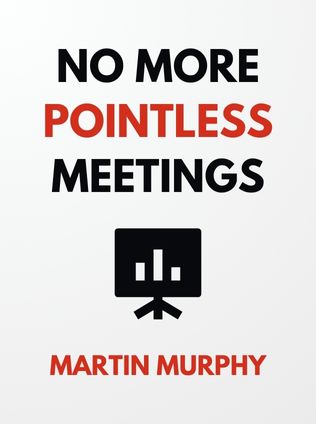
No More Pointless Meetings
Breakthrough Sessions That Will Revolutionize the Way You Work
By Martin Murphy
Published 10/2012
About the Author
Martin Murphy, founder, and president of QuantumMeetings, is a renowned management consultant specializing in transforming traditional meeting structures into productive workflow sessions. With an impressive client list including The Coca-Cola Co., PepsiCo, IBM, Pillsbury, and more, Murphy has established himself as an expert in optimizing organizational collaboration. His book, "No More Pointless Meetings," embodies his innovative approach to meeting management, providing actionable strategies to enhance productivity and foster innovation.
Main Idea
Meetings are an essential part of corporate life but often fail to produce desired results. Martin Murphy's "No More Pointless Meetings" offers a revolutionary approach to transforming these traditional, time-consuming gatherings into efficient, results-driven workflow sessions. By reframing meetings into four critical activities—Issues Management, Innovation, Problem-Solving, and Ongoing Planning—Murphy provides a structured method to maximize cognitive and creative potential, ensuring early ownership of issues, accountability, and transparency.
Table of Contents
- Why Meetings Fail: Reframing Workflow Management
- The Issues Management Session
- The Innovation Session
- The Problem-Solving Session
- The Ongoing Planning Process
- One-on-One Sessions
- Solo Sessions
- Making It Happen
Why Meetings Fail: Reframing Workflow Management
Traditional meetings are often ineffective because they fail to separate content from process and place too much control in the hands of the highest-ranking individual present. Murphy argues that meetings need to be restructured into workflow management sessions, focusing on four main activities: managing issues, solving problems, innovating, and ongoing planning. By doing so, organizations can significantly improve their collaborative efforts and overall productivity.
"Meetings have survived as the primary collaborative process because it is assumed that an individual, once promoted to a leadership position, already knows how to effectively leverage human capital." – Martin Murphy
Guiding Principles
- Separate content and process to enhance productivity.
- Facilitators should handle the process, while participants manage content.
The traditional meeting model is ingrained in corporate culture, but its shortcomings are well-known. Often, meetings are dominated by senior executives who both participate and control the process, leading to inefficiency and lack of focus. Murphy's approach emphasizes the need to separate the roles of content management and process facilitation. By assigning a facilitator to handle the process, participants can focus solely on the content, leading to more productive outcomes.
The Issues Management Session
Issues management is about addressing anything that affects the organization's welfare, from resolving immediate problems to exploring trends and opportunities. Murphy provides a step-by-step process to conduct an effective Issues Management Session:
- Laying the Groundwork: Establish the difference between conventional meetings and workflow sessions. Record all emerging questions as "Information Gaps."
- Identify the Purpose: Ensure all participants understand the session's purpose.
- Surface All Issues: Have participants list all relevant issues without discussion.
- Narrow to Critical Issues: Identify the top critical issues through a ranking process.
- Resolve or Move Issues: Decide which issues can be resolved in-session and which need further sessions.
- Write the Action Plan: Document conclusions, solutions, and next steps, ensuring accountability and transparency.
"An Action Plan ensures outcomes are implemented in a manner that optimizes accountability, transparency, and speed-to-market performance." – Martin Murphy
The Issues Management Session is designed to handle expanding workloads and streamline day-to-day operations. By surfacing all potential issues and then narrowing them down to critical ones, organizations can focus on what truly matters. This method not only improves efficiency but also ensures that critical issues are addressed promptly, preventing them from escalating into larger problems.
Sign up for FREE and get access to 1,400+ books summaries.
You May Also Like
The Life-Changing Magic of Tidying Up
The Japanese Art of Decluttering and Organizing
By Marie KondoThe Lean Startup
How Today's Entrepreneurs Use Continuous Innovation to Create Radically Successful Businesses
By Eric RiesWho Moved My Cheese?
An Amazing Way to Deal with Change in Your Work and in Your Life
By Spencer Johnson, M.D.Make Your Bed
Little Things That Can Change Your Life...And Maybe the World
By William H. McRaven



















